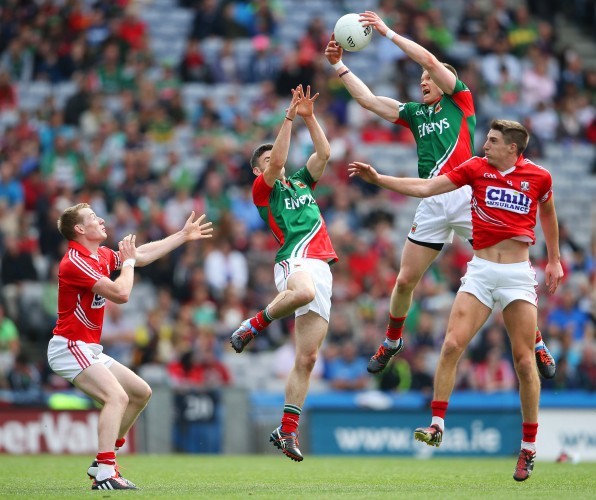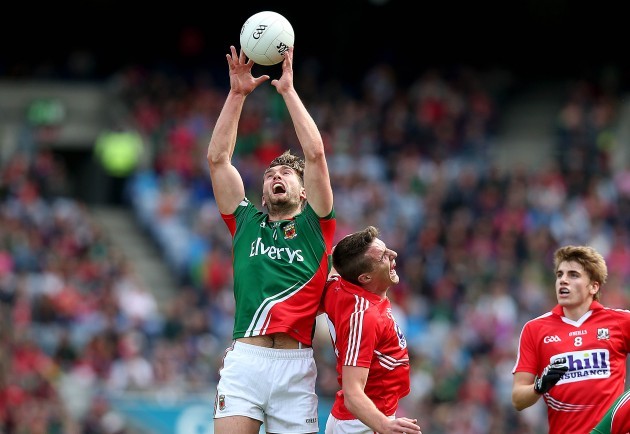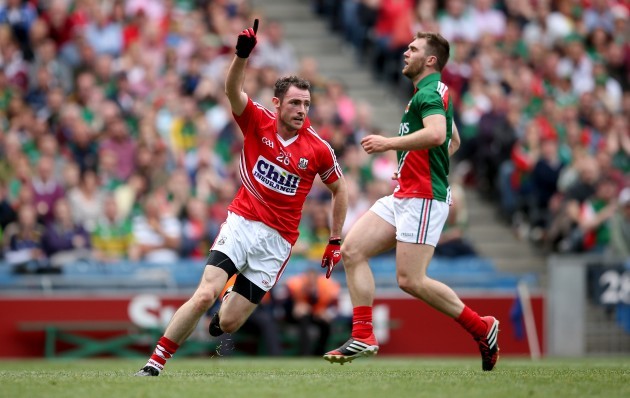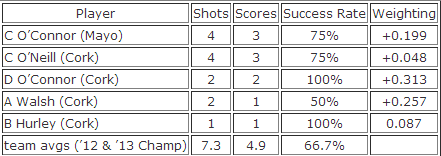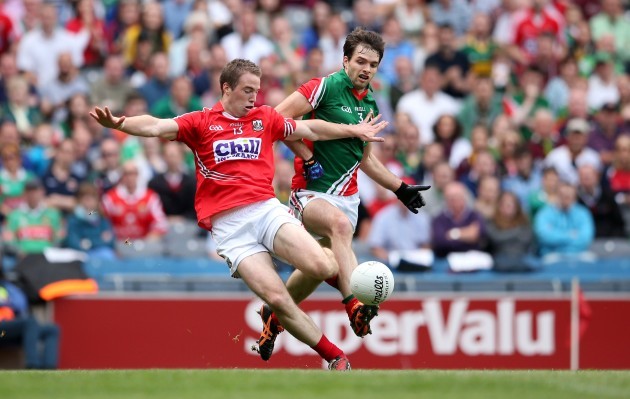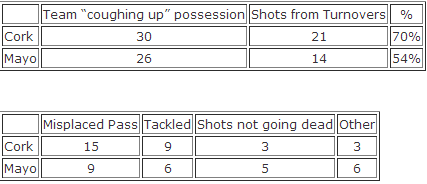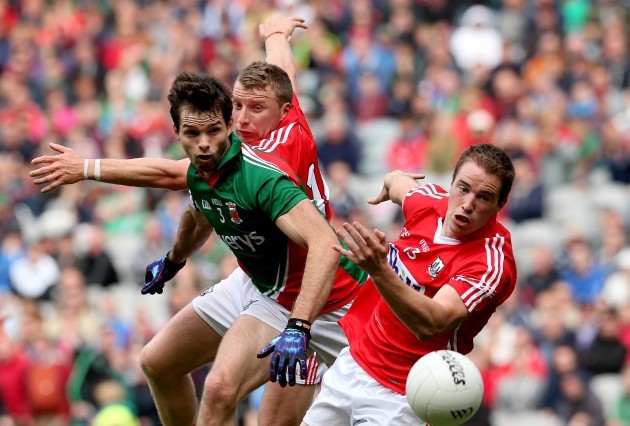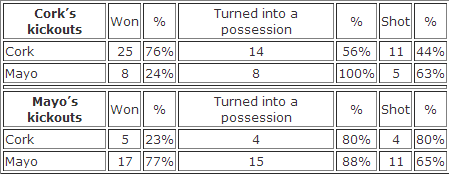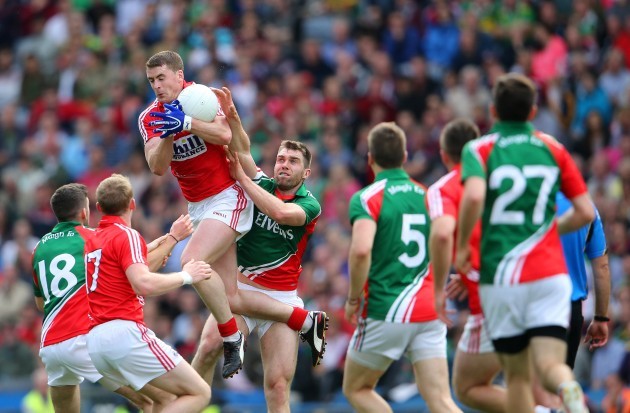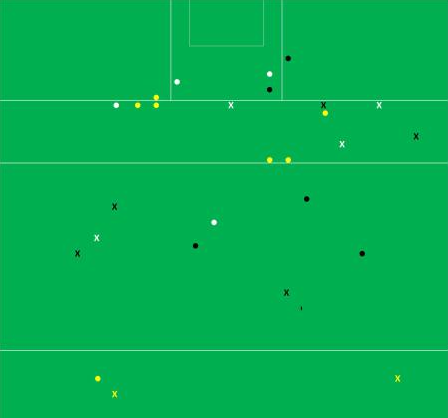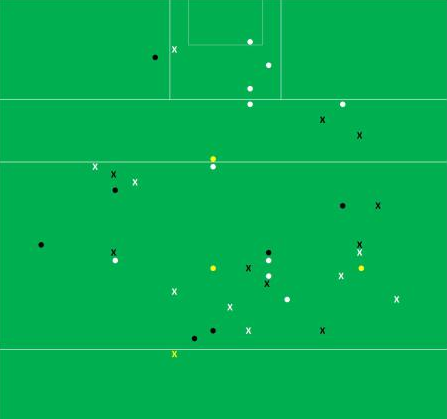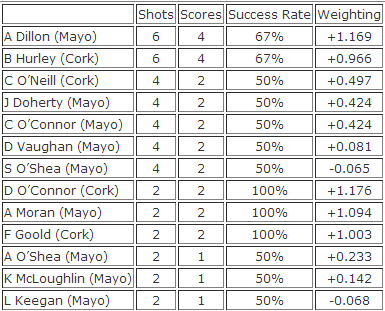Please find a refresher on the definitions and how the numbers are compiled here.
******
Overall
In the game of percentages Cork won easily. They had a higher Shot Rate and an excellent Success Rate – the problem was that Mayo’s volume of attacking possessions was just so large that no excellence in shooting could bridge the gap.
That’s not to say that some of Mayo’s shooting was not excellent. It was – especially towards the end with Vaughan’s point under pressure & O’Connor’s free from the right with the right foot. But generally speaking Mayo had the volume of shots whereas Cork had the accuracy.
That volume of attacks is a huge step up on what Mayo have produced this year (41 against Galway & 36 against Roscommon). Even in the hammerings they dispensed in last year’s Championship to Galway (x36 attacks), London (x46) and Donegal (x49) they never breached 50.
Some will argue that part of that volume can be attributed to the Cork system which, with two deep lying sweepers in the first half, invited Mayo to carry the ball to the 45 however this does not entirely explain it – indeed the half splits were 24 attacks in the first half and 26 in the second. The next table however goes some way to explain just how Mayo had so many attacks.
Where attacks originated
Mayo manufactured 12 extra possessions from outside their 65m line. By sitting back and not pressuring Mayo Cork only really collected the ball inside their own 45. Mayo on the other hand manufactured easy attacks by receiving the ball in prime positions time and again. Given how well Cork were shooting it was gaining these easy attacks that was the difference maker.
Shots from Play
35 shots from play is up there with Dublin’s returns (34 v Laois, 37 vWexford & a ridiculous 41 v Meath) whilst a Success Rate of 49% is healthy.
The one aspect of this that might concern James Horan and his backroom team is how relatively few goal shots there were. In total they went for goal three times in this game which followed on the four attempts in the Galway game and zero against Roscommon. For the three games in which they have been featured on TV Mayo are running at a goal shot every 9.29 point attempts. Dublin are running at a goal shot for every 4.09 attempts at a point.
Of interest is the fact that Mayo only converted 14% (1 from 7) of their shots from the right between the 20 & 45m line. There was no one culprit with six different players missing from that area. In the previous two games their Success Rate from this sector was 38% (5 from 13) – which is about bang on average. It would appear to be “one of those things” but definitely something to keep an eye on in the semi final.
As a contrast Cork converted three of their four attempts from the same area but the fact that they had 16 shots for a point, as opposed to Mayo’s 32, just emphasises the problems they had manufacturing scores.
Despite their excellent returns from the right one thing that is evident on the shot charts below is how infrequently Cork were able to get a shot off from in front of goal beyond the 20m line. Mayo had eleven shots from this productive central area – Cork had three.
Shots from deadballs
All round solid displays without anyone being spectacular. We have seen a trend towards longer attempts at goal this year (Beggan, Morgan & Murphy spring to mind) and Cork had three attempts from outside the 45 in this game. Walsh was successful with one mammoth free but missed a second whilst O’Neill also missed one from beyond the 45.
One from three is about par but given the general excellence of Cork deadball striking over the years this is an area they would have hoped to gain an advantage from – over the three games they were on TV this year their Success Rate from long range frees was 38% (3 from 8) with a weighting of -0.4977.
One thing to note is that Mayo only won four frees within shooting range (3 points from O’Connor and one that was quickly taken to Vaughan for a fisted point). In their two previous games against Galway & Roscommon they won 6 & 7 respectively so it is not something they will dwell on but credit should be given to the Cork backs for their discipline in marking the Mayo forward line.
O’Neill shows up well here for Cork – I had him winning five of the six frees Cork attempted inside the 45. Incidentally Tom Cunniffe gave away three of these fouls with Cafferkey (x2) & Keegan being the other culprits.
Turnovers
Mayo were able to transition 70% of the turnovers they manufactured (or received!) into shots. On such a high volume of turnovers that is a remarkable percentage.
Of course what helped them to maintain such a high percentage was where they won their turnovers. 9 of the 30 were won inside Cork’s 65 with Mayo getting a shot from all nine and scoring 1-05.
Nine turnovers that high up the pitch is a phenomenal number. Mayo got 5 such turnovers against Roscommon and four against Galway whilst the highest Dublin have managed this year is 7 (V Meath). Those turnovers are Class A counter attack possessions and Mayo were clinical in how they dispatched them.
Kickouts
I define winning a kickout as being the first team to gain possession of the ball – in that respect Cork did not do too badly. Yes they had five more kickouts than Mayo but if you gave Cork essential parity – in terms of shots generated from kickout possessions – prior to the game I think they would have taken it.
Of course whilst the raw numbers here seem to show Cork acquitting themselves adequately they did have trouble on their own kickouts. We have seen that Mayo pressed very effectively in Cork’s half and the fact that Cork were willing to go short so often to protect possession enabled them to do this. Cork may have gotten their hands on the ball first (on 16 of 17 short kickouts) but often times they did so under extreme pressure (Doherty robbing Kelly & Cadogan having a hand pass intercepted spring to mind).
When they did kick past the 45 it became much more of a contest with Cork winning the possession battle 9-7 on the remaining 16 kickouts. But again of those nine wins seven were done so with a Mayo man contesting the kickout.
Mayo won 77% of their own kickouts but the remarkable thing about this is that they only went short three times. Whereas Cork won 56% of their own kickout that landed beyond the 45 Mayo won a hugely impressive 74%.
The fact that they won the kickout so far from their own goal enabled them to turn such a high percentage (92%) of their wins into attacks
As a complete aside the fact that Mayo were having such dominance on contested kickouts is a reason why I would have attempted to manufacture a goal attempt with that last free. Granted Cork won the previous Mayo kickout – and A O’Shea was off the pitch – but Cork must have had a <40% chance of gaining possession from that kickout.
Shot Charts
Cork’s shooting
Mayo’s shooting
x = missed, disc = score, yellow = deadball, black = 1st half from play, white = 2nd half from play
Players with >= 2 shots from play
Alan Dillon had a very productive day only missing on one of his five attempts for a point whilst his other miss was a shot at goal from very close range attempted when O’Halloran was on top of him.
********
Reproduced with kind permission of James Robinson (@dontfoul ). This article first appeared on the Don’t Foul website.
